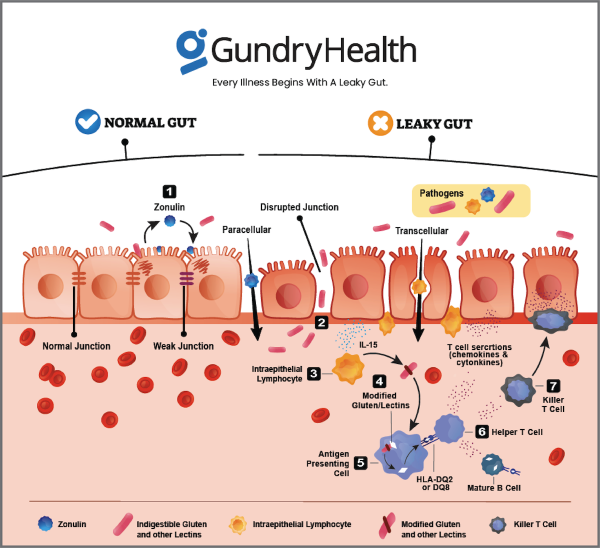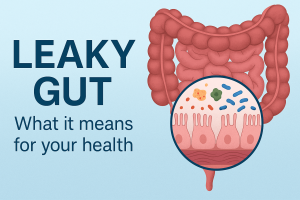Revealed: The Surprising Connection between Rosacea, Diet, and Gut Health.
Former cardiothoracic surgeon and New York Times bestselling author Dr. Steven Gundry explains how a leaky gut can lead to rosacea and what you can do to prevent and treat this autoimmune condition.
What is rosacea?
Rosacea is a chronic skin condition typically affecting the face and eyes. It affects over 16 million Americans and is characterized by redness, pimples, and broken blood vessels.
What are the symptoms of rosacea?
Common symptoms of rosacea include the following:
- Facial flushing – this includes blushing or flushing (redness) on the central part of the face.
- Swollen bumps (pimples) – these bumps can often resemble acne and can sometimes contain pus. These usually develop in combination with other symptoms like facial flushing.
- Visible veins – look out for small blood vessels on the nose and cheeks breaking and becoming visible (these are sometimes called “spider veins”).
- Burning sensation – affected skin may feel hot to the touch.
- Eye symptoms – people with rosacea may also experience redness, burning, and tearing of the eyes. They may also experience inflamed eyelids or a sensation that something is in the eye.
- Enlarged nose – over time, enlarged oil glands in the nose can cause it to appear red and bulbous.
What are the different types of rosacea?
There are four different types of rosacea. These include the following:
- Subtype one – this form of rosacea is commonly associated with symptoms such as facial redness, flushing, and visible blood vessels (see list of symptoms above).
- Subtype two – this type is most common among middle-aged women and is commonly associated with acne-like breakouts (swollen bumps – see list of symptoms for more information).
- Subtype three – this type of rosacea is rare and is characterized by thickening of the skin on the nose. It most commonly affects men.
- Subtype four – this is the form of rosacea that affects the eyes, which is why it’s also referred to as ocular rosacea.
Who is most at risk of rosacea?
Rosacea most commonly affects people between the ages of 30 and 50. It appears to be more common in people with fair skin and light-colored eyes (although it can affect anybody).
There also appear to be genetic links to rosacea. You are more likely to develop rosacea if you have a family history of the condition or if you have British or Scandinavian ancestry.
Statistically, women are more likely to develop rosacea than men.
What causes rosacea?
The root cause of rosacea is unknown, but there are several known causes of flare-ups. One of the major causes is diet. A 2005 survey by the National Rosacea Society found that 78 percent of respondents made changes to their diet in order to control their symptoms. Of those 78 percent, a full 95 percent reported experiencing fewer symptoms.
Is rosacea an autoimmune condition?
According to mainstream medical advice, rosacea is not an autoimmune condition. However, there’s persuasive evidence linking rosacea to gastrointestinal autoimmune diseases like celiac disease and irritable bowel disease.
Although modern medicine has only recently made the connection between skin and gut health, best-selling author Dr. Steven Gundry has linked these two for decades. According to Dr. Gundry, your GI tract is your skin turned inside out. And like your GI tract, your skin contains trillions of microbes.
Your skin also has two primary functions. Its first job is to protect you from the outside world. Its second – and perhaps more important – job is to absorb and get rid of materials.
This suggests a strong connection between the skin, the gut, and the immune system. It also means that changes to diet could also have an effect on many of the most common symptoms of rosacea (including flare-ups of the condition).
The gut-skin axis and rosacea
This gut-skin axis – the direct relationship between your gut, including your digestive system and all the bacteria and microorganisms that call your gut home, collectively called your microbiome and your skin – may be a surprising “silver bullet” for treating rosacea.
Put simply, your gut actually is in constant communication with other parts of your body, including your skin. So when any aspect of your delicate microbiome is out-of-balance, the health of your entire body can suffer – including the health of your skin.
In fact, scientists have found that people with eczema (including rosacea) have different bacteria in their gut and different bacteria on their skin than people without eczema. But how and why does this happen?
You see, the immune cells along your gut lining play an important role in keeping your gut wall strong. They decide what can leave the GI tract and what must stay contained.
When everything is working well, nothing gets through this strong gut barrier except what’s supposed to. However, when this barrier gets worn down (more on that below) and develops more and more microscopic holes, it allows other compounds to “leak” through, causing your health to suffer.
Is rosacea a symptom of leaky gut?
This is the condition known as “leaky gut.”
So when the wrong molecules or even bacteria get across the border of your gut wall, your immune system kicks into high gear. Normally, this is really important since your immune system can call in “reinforcements” – inflammatory hormones called cytokines. These cytokines can save your life from a bacterial infection and help you heal when you have an injury.
The problem starts when your immune system starts responding to every little thing. Think of it like an overactive security alarm system. You’re grateful when it alerts you to the presence of a thief, but you’re annoyed when it goes off every time a fly enters your home.
That’s exactly what happens when you have a leaky gut. Your immune system begins responding to everything that gets through your porous gut wall. This leads to chronic inflammation – including the kind of inflammation on your skin that causes rosacea.
How to treat your rosacea – a surprising new approach
In order to start reducing your rosacea symptoms, you need to understand what causes a leaky gut in the first place. When you take care of the problem at the source, you can dramatically lessen the frequency and severity of your rosacea.
Imagine your body is a fortress. You need a wall to protect yourself. That’s your gut wall. Immune cells are the soldiers there to protect your fortress. Their job is to detect friend from foe. And when they fight for you, they cause collateral damage. We call that collateral damage inflammation.
However, your protective walls aren’t sealed shut. All along the wall are tiny doors. And while these doors are closed most of the time, sometimes they need to open to allow food or friends to come in.
So imagine what would happen if those doors were always open. It would be much harder for your soldiers to defend the fortress (your body). Now, there is a molecule (called zonulin) inside your body that makes these “doors” in your gut wall open or close. And there are certain environmental triggers that make your cells produce zonulin.
One such trigger is a type of protein called a lectin. Plants produce lectins as a defense against being eaten. In fact, lectins are so powerful they can even paralyze the bugs that eat them.
Of course, you’re a lot bigger and stronger than a little bug. And you have your own defense mechanisms, like mucus, which can bind to lectin proteins and make them harmless as you digest them.
However, as humans have consumed more and more lectin-rich foods (like tomatoes, potatoes, beans, and most grains) our natural defenses against these pesky proteins have begun to weaken.
And when lectins make it through to your GI tract, they can cause all kinds of problems. For one, they bind with receptors along the gut lining to produce zonulin. As explained above, zonulin then breaks the tight junctions holding together your gut wall. This creates spaces between the cells for “foreign invaders” (like harmful bacteria) to get through and get to other parts of your body.
The result? Inflammation.
This is why reducing lectin consumption is a major part of Dr. Steven Gundry’s health program. (Click HERE to find a complete list of lectin-containing foods you should avoid if you’re suffering from rosacea.)
Dr. Gundry is a former cardiothoracic surgeon and author who has helped thousands of his patients – and many more people through his best-selling books – to get rid of their autoimmune diseases, including rosacea. He’s done this by utilizing the latest blood and laboratory tests and combining these test results with a comprehensive personalized diet and nutrition program.
Get personalized care and recommendations for rosacea from Dr. Gundry-Approved care coordinators
If you’re looking for more guidance about rosacea, Dr. Gundry’s unique health program is now available to you (without needing an appointment at one of Dr. Gundry’s two waitlist-only West Coast clinics).
Thanks to the pioneering work of Dr. Gundry and his team at Gundry Health, care coordinators trained in Dr. Gundry’s unique holistic methods are now available to help you craft your own personalized eczema program.







